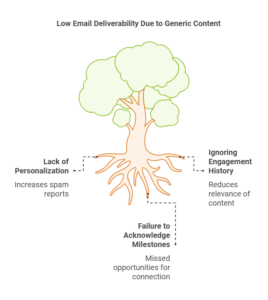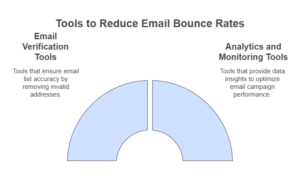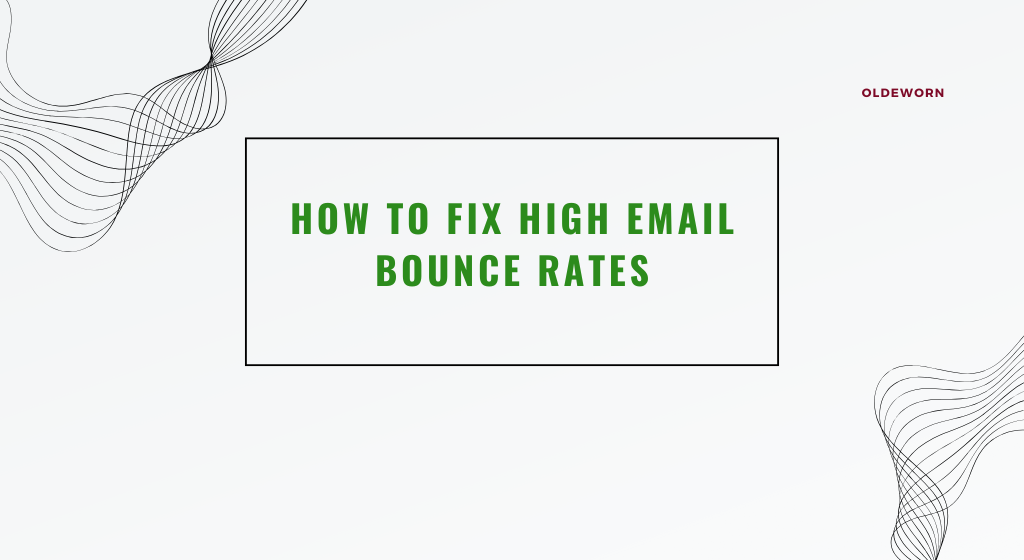Email marketing is one of the most effective tools for reaching your audience, but high email bounce rates can sabotage your efforts. Whether you’re seeing hard bounces or soft bounces, a bloated bounce rate is a clear signal that something’s wrong. In this article, we’ll dive deep into fixing this issue and ensuring your emails land where they should—your recipients’ inboxes.
Understanding Email Bounce Rates
What is an Email Bounce Rate?
An email bounce rate refers to the percentage of emails that cannot be delivered to recipients’ inboxes. When you send an email and it fails to reach its destination, that’s a “bounce.” This can happen for various reasons, and understanding these is the first step toward solving the problem.
Bounces are usually flagged by email service providers (ESPs) and can lead to poor sender reputations. This, in turn, affects future email campaigns. If you’re experiencing bounce rates above 2%, you need to take action.
Types of Email Bounces: Soft vs. Hard Bounces
Not all bounces are created equal. There are two main types:
- Hard Bounces:
These occur when an email address is invalid, closed, or doesn’t exist. They are permanent delivery failures and must be addressed immediately. - Soft Bounces:
These are temporary failures due to issues like a full inbox or a server outage. While soft bounces may resolve themselves, repeated occurrences could signal a problem with your email practices.
By identifying whether your issue lies with soft or hard bounces, you can better tailor your strategy.
Why High Bounce Rates Hurt Your Campaigns
High email bounce rates do more than just skew your campaign metrics—they harm your sender reputation. Email providers monitor bounce rates to determine whether your emails are safe and trustworthy. If your bounce rate climbs too high, your emails might end up in spam folders or get blocked entirely.
Here’s what else is at stake:
- Lower Open Rates: Emails failing to deliver mean fewer opportunities for engagement.
- Damage to Reputation: Major ISPs like Gmail and Outlook may blacklist your domain.
- Wasted Resources: You spend time and money crafting emails that never reach your audience.
To prevent these consequences, fixing your bounce rate should be a top priority.
Common Causes of High Email Bounce Rates
Invalid or Inactive Email Addresses
One of the most common culprits is sending emails to invalid or inactive addresses. These can include typos (e.g., johnsmith@gmil.com) or accounts that have been abandoned by users.
How do these creep into your list? Often, they’re the result of forms that don’t validate input, imported lists from questionable sources, or outdated data.
Poor Email List Hygiene
Let’s face it: not everyone on your email list stays interested forever. A lack of maintenance can lead to a pile-up of inactive or fake addresses. If you’re not cleaning your list regularly, these dead-end emails can inflate your bounce rate.
Sending Without Authentication
Email authentication (via protocols like SPF, DKIM, and DMARC) is critical. Without it, your emails might be flagged as suspicious, leading ISPs to block them. Authentication acts as your email’s passport—it shows that your messages are legitimate.
High Spam Complaints
If users mark your emails as spam, your bounce rate might indirectly increase. How? Providers like Gmail take user feedback seriously. If too many complaints pile up, they might reject your emails outright, categorizing them as untrustworthy.
Effective Strategies to Fix High Email Bounce Rates
Maintain a Clean Email List
Cleaning your email list is like decluttering your inbox—it makes everything run more smoothly.
- Regularly Remove Inactive Subscribers: If someone hasn’t engaged with your emails in 6–12 months, consider removing them or running a re-engagement campaign.
- Use Double Opt-Ins: This ensures that only interested, valid users are added to your list. Double opt-ins require users to confirm their subscription via a follow-up email, reducing the chances of fake addresses slipping through.
Validate Email Addresses
Email validation is a game-changer. Tools like ZeroBounce and NeverBounce can check your list for invalid addresses.
- Spot Common Email Typos: A simple mistake like “gmial” instead of “gmail” can cause delivery issues. These tools catch such errors before they impact your campaigns.
- Use Email Verification Tools: These services identify whether an address exists and is capable of receiving mail.
Optimize Email Sending Practices
Poor email practices can lead to higher bounce rates, even if your list is clean.
- Authenticate Emails with SPF, DKIM, and DMARC: These protocols verify your identity to ISPs and prevent your emails from being flagged.
- Avoid Triggering Spam Filters: Words like “FREE” in all caps or excessive exclamation marks can doom your email. Test your emails using tools like Mail Tester to ensure they’re optimized.
Best Practices for Ongoing Email Deliverability
Personalize Email Content
Generic emails are a quick way to lose subscribers. Personalization goes beyond addressing your recipient by their first name. Tailor your content to their preferences, past interactions, and demographics.
For example:
- Use their purchase history to suggest relevant products.
- Acknowledge their engagement milestones, such as anniversaries or loyalty rewards.
Not only does personalization boost engagement, but it also reduces the likelihood of recipients marking your emails as spam—a major contributor to bounce rates.

Segment Your Email List
Think of your email list as a group of different communities. Not everyone in your list has the same interests, behaviors, or stage in the customer journey. Segmentation allows you to target specific groups with content relevant to them.
Popular segmentation strategies include:
- Behavior-based: Separate frequent buyers from first-timers.
- Geographic: Tailor messages based on location for relevance.
- Engagement level: Create separate campaigns for active and inactive users.
This approach improves open rates, lowers complaints, and naturally reduces bounce rates.
Use a Consistent Sending Schedule
Irregular email sending can confuse your audience and signal spam-like behavior to email providers. Establishing a regular cadence helps maintain engagement and ensures your emails aren’t forgotten—or worse, flagged.
Stick to a schedule that suits your audience’s preferences. Tools like A/B testing can help determine the best days and times for optimal delivery.
Tools to Help Reduce Email Bounce Rates
Email Verification Tools
Email verification tools are essential for cleaning up your lists and ensuring high deliverability. Here are some of the top options:
- ZeroBounce: Offers real-time email verification and scoring to eliminate invalid addresses.
- NeverBounce: Checks for fake or duplicate emails and provides actionable insights to improve list quality.
- Hunter: Verifies professional email addresses and identifies temporary domains.
These tools integrate with most email marketing platforms, streamlining the process of maintaining list hygiene.
Analytics and Monitoring Tools
Your email campaigns should be data-driven, and analytics tools can provide the insights you need. Platforms like Mailchimp, Constant Contact, and HubSpot allow you to monitor bounce rates, open rates, and click-through rates.
Pro tip: Set alerts for significant bounce rate spikes so you can take corrective action immediately.

How to Monitor and Analyze Email Bounce Rates
Using Email Marketing Platforms for Bounce Insights
Most modern email marketing platforms categorize bounces and provide reports. For instance:
- Soft vs. Hard Bounces: Platforms like Mailchimp clearly separate these categories for easy analysis.
- Actionable Metrics: Many platforms offer suggestions for cleaning up lists based on bounce data.
Understanding the root cause of your bounces helps you refine your strategy and avoid the same issues in the future.
Setting Up Bounce Rate Benchmarks
Knowing what constitutes a “normal” bounce rate for your industry is crucial. Generally:
- 1–2% Bounce Rate: Acceptable for most industries.
- 3–5% Bounce Rate: Indicates list hygiene or content issues.
- Above 5%: Urgent action required.
Compare your metrics to industry standards and aim for continuous improvement.
Real-World Examples: Successful Email Bounce Rate Fixes
Example 1: Reducing Hard Bounces in a Marketing Campaign
A SaaS company struggling with hard bounces discovered they had outdated email lists from past trade shows. After integrating email verification tools and removing invalid addresses, their bounce rate dropped from 7% to 1.8%.
They also introduced double opt-ins to prevent unverified sign-ups in the future.
Example 2: Improving Soft Bounce Recovery
An eCommerce brand noticed a rise in soft bounces during peak holiday sales. Analysis revealed server issues and overwhelmed inboxes. By segmenting frequent buyers and rescheduling emails during off-peak hours, they minimized soft bounces and improved engagement.
Frequently Asked Questions about Email Bounce Rates
1. What is a good email bounce rate?
A good email bounce rate is below 2%. Anything higher signals problems with your list quality or email practices.
2. How often should I clean my email list?
Ideally, you should clean your email list every 3–6 months. Regular cleaning ensures you’re targeting engaged and valid email addresses.
3. Can personalization help reduce bounce rates?
Yes, personalized emails are less likely to be marked as spam, which indirectly reduces bounce rates. Tailored content improves recipient engagement and trust.
4. Are free email verification tools effective?
Free tools can help, but they often lack advanced features like real-time verification and scoring. Investing in paid tools like ZeroBounce can yield better results.
5. What happens if my bounce rate is too high?
A high bounce rate can damage your sender reputation, leading to emails being marked as spam or blocked entirely. Immediate action is required to clean your list and fix delivery issues.
Conclusion
High email bounce rates can seem like a daunting challenge, but with the right strategies and tools, they’re entirely fixable. From maintaining a clean email list to leveraging analytics, every step you take improves your email deliverability and strengthens your campaigns. Start implementing these tips today, and watch your bounce rates plummet while engagement soars.




